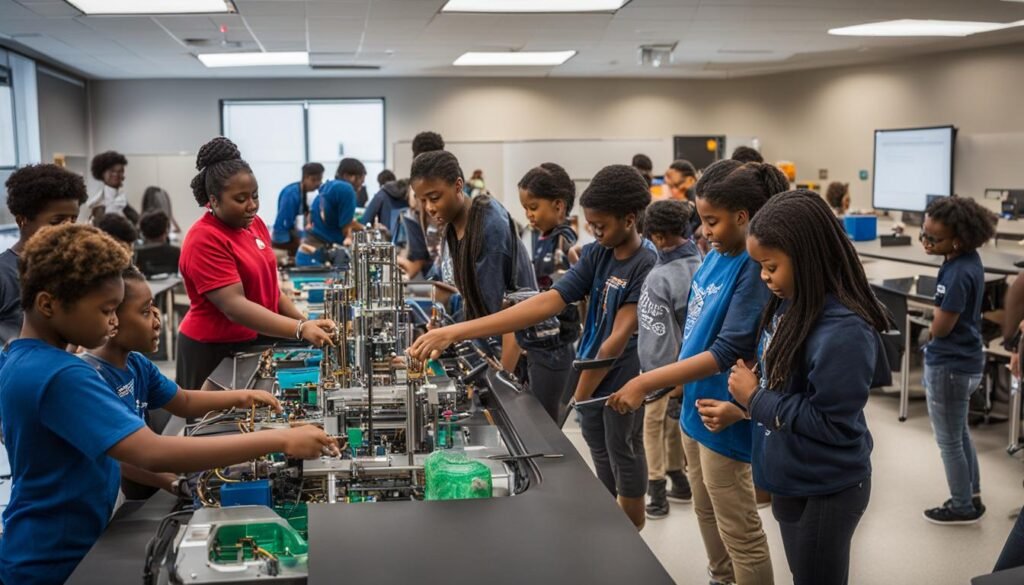Education free in usa is a fundamental right that should be accessible to all. In the United States, there are various education programs that offer free education options, providing opportunities for students to learn and thrive. Whether it’s public education in tuition-free public schools or scholarships for private schools, education free in the USA opens doors to a brighter future for many.
Also Read: Explore Data At The National Center For Education Statistics
Key Takeaways:
- Education free in the USA provides equal access to quality education.
- Public education in tuition-free public schools is available to all students.
- Scholarships and financial aid programs support students in attending private schools.
- Education free in the USA is a stepping stone towards a better future.
- Investing in education helps strengthen the nation’s workforce and economy.
Understanding the Coleman Report and its Findings
The Coleman report, led by James S. Coleman, shed light on the factors contributing to the achievement gap between black and white students in the US. It revealed that family background, rather than school funding or resources, plays a significant role in student outcomes. The report’s findings challenged the commonly held belief that schools have a substantial impact on student achievement.
According to the Coleman report, differences in school funding and resources do not explain the disparities in test scores between black and white students. Instead, family background factors such as parental income, education level, wealth, and aspirations for their children are key determinants of student success. This highlights the importance of addressing equity in education and providing equal opportunities for all students, irrespective of their family background.
The Coleman report emphasized that schools have limited independent influence on student achievement compared to their background and social context. While schools get free play a role in reducing inequality, especially among young children, addressing the achievement gap requires a broader understanding of the systemic factors that contribute to educational disparities.
Also Read: Truth Or Myth: Is A Grand Canyon University Degree Worthless?
“The Coleman report’s findings challenged existing assumptions about the role of schools in closing achievement gaps and sparked a reevaluation of social policy and education research.”
Understanding the Coleman report and its findings is crucial for policymakers, educators, and researchers to design effective strategies for improving student achievement and narrowing the achievement gap. By focusing on equitable access to quality education go to college and addressing the systemic factors that perpetuate educational disparities, we can create a more inclusive and prosperous future for all students.
The Impact of the Coleman Report
The Coleman report, published 50 years ago, had a profound impact on social policy and education research in the United States. Its findings challenged existing assumptions about the role of schools in closing the achievement gap, particularly in relation to racial and socioeconomic disparities. Contrary to popular belief, the report concluded that school quality has limited independent influence on student outcomes.
The report’s conclusion sparked a strong reaction in the policy world, leading to a reevaluation of the way schools were seen as a tool for reducing inequality. The findings highlighted the importance school in the united states of addressing social and economic factors, such as family background and community support, in order to improve student outcomes. As a result, social policy initiatives shifted their focus from a narrow perspective of school quality to a broader approach that considered the broader social context of students.
Also Read: Exploring University Of Maryland Midtown Campus – Key Guide
“School quality has limited independent influence on student outcomes.”
Education research also underwent a transformation as a result of the Coleman report. The report’s emphasis on the importance of family background and social context paved the way for new research questions and methodologies. Researchers began exploring the impact of factors such as parental income, education, and aspirations on student achievement. This shift in perspective led to a more comprehensive understanding of the complex interplay between schools, families, and communities in shaping student outcomes.
| Impact of the Coleman Report | |
|---|---|
| Shifted focus from school quality to social and economic factors | ✓ |
| Influenced social policy initiatives | ✓ |
| Transformed education research | ✓ |
| Highlighted the role of family background and social context | ✓ |
In conclusion, the Coleman report had a significant impact on social policy and education research in the United States. Its findings challenged traditional notions about the role of schools in reducing the achievement gap and led to a broader understanding of the complex factors that influence student outcomes. By recognizing the importance of family background and social context, policymakers and researchers have been able to develop more holistic approaches to improving education and reducing inequality.
Also Read: Unlocking Success With South Carolina Department Of Education

Public-Private Partnerships for STEM Education
The “Educate to Innovate” campaign, launched by President Obama, aims to improve STEM education in the US. The campaign involves public-private partnerships with leading companies, foundations, non-profits, and science and engineering societies. These partnerships focus on motivating and inspiring students in science and math through the use of media, interactive games, and hands-on learning. The campaign has received over $260 million in financial and in-kind support and aims to reach more than 10 million students in the next four years.
Public-private partnerships are crucial in enhancing STEM education across the country. By bringing together the resources and expertise of both the public and private sectors, these partnerships can provide students with innovative learning opportunities and expose them to real-world applications of science and math. Through media and interactive games, students can engage with STEM subjects in a fun and interactive way, fostering their interest and passion for these fields.
Also Read: Experience Howard University Campus Life: Engaging & Cultured
These partnerships also help bridge the gap between education and industry, ensuring that students are prepared for the demands of the workforce. By collaborating with leading companies and organizations, students can gain insights into potential careers and develop the skills necessary for success in STEM-related professions. Through hands-on learning experiences and mentorship programs, students can explore their interests and cultivate their talents in science and math.
Benefits of Public-Private Partnerships for STEM Education
- Access to resources and expertise from both the public and private sectors
- Motivating and inspiring students through media and interactive games
- Real-world applications of science and math
- Bridging the gap between education and industry
- Preparing students for the demands of the STEM workforce
- Hands-on learning experiences and mentorship programs
Public-private partnerships play a vital role in promoting STEM education in the US. By leveraging the strengths of both sectors, these collaborations have the potential to empower and equip students with the knowledge and skills they need to thrive in the 21st century.

Private-Sector Support for STEM Education
Private-sector and philanthropic support play a crucial role in advancing STEM education in the United States. Leaders such as Sally Ride, Craig Barrett, Ursula Burns, Glenn Britt, and Antonio Perez have pledged their commitment to increasing support for STEM education. With the backing of organizations like the Bill and Melinda Gates Foundation and the Carnegie Corporation of New York, these leaders aim to make a significant impact.
Through their collective efforts, this coalition seeks to recruit private sector leaders as STEM champions, who will advocate for the importance of STEM education and inspire others to get involved. Additionally, they aim to scale successful STEM innovations, investing in programs and initiatives that have proven to be effective in engaging students and fostering their interest in science, technology, engineering, and math.
One of the primary goals of this initiative is to raise awareness about the importance of STEM education among parents and students. By highlighting the real-world applications and career opportunities available in STEM fields, they hope to encourage more students to pursue these subjects and equip them with the skills needed for the future workforce.

Private-Sector Support Table
| Supporter | Organization | Focus Areas |
|---|---|---|
| Sally Ride | Independent | STEM advocacy, women in STEM |
| Craig Barrett | Retired Chairman and CEO of Intel Corporation | STEM mentorship, education reform |
| Ursula Burns | Former CEO of Xerox Corporation | STEM diversity and inclusion |
| Glenn Britt | Former Chairman and CEO of Time Warner Cable | STEM funding, education policy |
| Antonio Perez | Former CEO of Eastman Kodak Company | STEM resources, technology integration |
Private-sector support, combined with philanthropic initiatives, holds the potential to transform STEM education in the United States. By leveraging the expertise, resources, and influence of these leaders, we can create a society that values and prioritizes STEM education, ensuring a bright future for our students and our country as a whole.
Initiatives to Promote STEM Education
As part of the efforts to promote STEM education, the White House will host an annual science fair showcasing student winners of national competitions in science, technology, and robotics. This initiative aims to recognize and celebrate the achievements of students in these fields and encourage their interest in STEM subjects. The science fair provides a platform for students to showcase their knowledge, skills, and innovations.
By bringing together the brightest young minds in science, technology, and robotics, the science fair cultivates a spirit of discovery and innovation. Students have the opportunity to demonstrate their projects and experiments, exchange ideas, and learn from one another. It is a chance for them to be inspired by the creativity and ingenuity of their peers, as well as to receive recognition and support for their own scientific endeavors.
Table: Science Fair Winners
| Year | Category | Winner | Project |
|---|---|---|---|
| 2020 | Science | Emily Johnson | Solar-Powered Water Purification System |
| 2020 | Technology | James Smith | Smart Home Automation |
| 2020 | Robotics | Sarah Davis | Autonomous Drone |
| 2019 | Science | Michael Thompson | Alternative Energy Solutions |
| 2019 | Technology | Jessica Wilson | Augmented Reality Gaming |
| 2019 | Robotics | David Brown | Autonomous Rover |
Through the science fair, the White House aims to foster a passion for STEM fields and inspire the next generation of scientists, engineers, and innovators. By showcasing the incredible projects and achievements of these students, the event highlights the importance of science, technology, and robotics in shaping our future.

The science fair is just one of the many initiatives aimed at promoting STEM education in the United States. By providing opportunities for students to explore and excel in these fields, we can ensure a bright future for innovation, technological advancement, and scientific discovery.
The Importance of STEM Education for America’s Future
STEM education plays a crucial role in shaping America’s future workforce and maintaining its economic leadership in the global arena. President Obama has emphasized three priorities for STEM education: increasing STEM literacy, improving the quality of math and science teaching, and expanding STEM education and career opportunities for underrepresented groups.
STEM literacy is essential for addressing the challenges of the 21st century, such as developing clean energy sources and finding cures for diseases. By equipping students with a strong foundation in science, technology, engineering, and math, we empower them to become innovative problem solvers and critical thinkers.
Improving the quality of math and science teaching is another key aspect of fostering STEM education. Highly qualified and motivated teachers can inspire and engage students, nurturing their interest and curiosity in STEM subjects. Providing professional development opportunities and resources for educators is crucial to ensure effective instruction and learning outcomes.
Expanding STEM education and career opportunities for underrepresented groups is essential for creating a diverse and inclusive STEM workforce. By removing barriers and promoting access to STEM education, we can tap into a broader pool of talent and perspectives. This will not only enhance innovation and creativity but also contribute to greater equity and social mobility.
The Impact of STEM Education
STEM education has far-reaching impacts on individuals, communities, and the nation as a whole. It equips students with the knowledge and skills needed to thrive in a technology-driven society, opening doors to a wide range of career opportunities. Moreover, a strong STEM workforce drives innovation, boosts economic growth, and ensures America’s competitiveness in the global marketplace.
| Benefits of STEM Education | Examples |
|---|---|
| Increased job opportunities | STEM-related fields such as software development, engineering, and healthcare offer high-paying and in-demand jobs. |
| Technological advancements | STEM innovations drive advancements in fields like renewable energy, artificial intelligence, and space exploration. |
| Improved problem-solving skills | STEM education fosters critical thinking, creativity, and analytical skills, enabling individuals to tackle complex challenges. |
| Economic growth and competitiveness | A robust STEM workforce drives innovation, fuels economic growth, and enhances America’s global competitiveness. |

“STEM education is not only about preparing students for specific careers; it is about equipping them with the skills and mindset to adapt and thrive in an ever-changing world.”
In conclusion, STEM education is vital for America’s future. By prioritizing STEM literacy, improving the quality of math and science teaching, and expanding opportunities for underrepresented groups, we can build a workforce equipped to tackle the challenges and seize the opportunities of the 21st century. Investing in STEM education is an investment in the prosperity and well-being of our nation.
Federal and State Efforts in STEM Education
The federal government has made significant strides in improving STEM education through various initiatives and programs. One of the notable initiatives is the Race to the Top program, which was established to incentivize states to enhance their STEM education offerings. With a budget of $4.35 billion, this program grants competitive advantages to states that commit to improving STEM education in their schools.
Key components of the Race to the Top program include raising educational standards, implementing data-driven instruction methods, improving teacher effectiveness, and integrating STEM professionals into classrooms. By focusing on these areas, the program aims to provide students with a high-quality STEM education that prepares them for future careers.
Also Read:- Explore Data At The National Center For Education Statistics
In addition to federal efforts, state-level initiatives supported by federal funding are also crucial for the success of STEM education. These initiatives often aim to bridge the gap between educational institutions and the needs of industries in their specific regions. By aligning curriculum with workforce demands and providing students with access to resources and opportunities, states can effectively improve STEM education.
| Initiatives | Details |
|---|---|
| Race to the Top | A federal program providing competitive advantages to states committed to improving STEM education. |
| Integration of STEM Professionals | Efforts to bring professionals from various STEM fields into classrooms to enhance instruction and provide real-world insights. |
| Data-Driven Instruction | Using data to inform teaching strategies and tailor instruction to individual student needs, ensuring effective learning outcomes. |
Collectively, these federal and state efforts in STEM education play a vital role in preparing students for the future workforce. By improving curriculum, instructional methods, and access to resources, these initiatives aim to cultivate a strong foundation in science, technology, engineering, and math. This, in turn, enables students to develop the critical thinking and problem-solving skills necessary for success in the 21st-century economy.
Conclusion
Education free in the USA presents a significant opportunity to address the achievement gap and cultivate a future workforce equipped for success. The Coleman report shed light on the impact of family background on student outcomes, emphasizing the need for equal access to education. By addressing educational disparities and investing in quality education, we can bridge the achievement gap and ensure that all students have the opportunity to thrive.
In line with this goal, President Obama’s “Educate to Innovate” campaign and the establishment of public-private partnerships focus on enhancing STEM education. These initiatives aim to prepare students for the future workforce by inspiring their interest in science, technology, engineering, and math. By equipping students with the necessary skills and knowledge, we can create a workforce capable of addressing the challenges of the 21st century.
STEM education is crucial for unlocking the potential of our future workforce. It not only cultivates STEM literacy but also improves the quality of math and science teaching. By expanding STEM education and career opportunities for underrepresented groups, we can ensure that all students have access to the pathways of success. Investing in STEM education is an investment in our future economic leadership and global competitiveness.
By recognizing the importance of education free in the USA, addressing the achievement gap, and prioritizing STEM education, we can shape a skilled and competitive schools are free workforce ready to tackle the challenges and opportunities that lie ahead. Together, we can build a brighter future for our students and our nation as a whole.
FAQs
Q: What did the Coleman report reveal?
The Coleman report revealed that family background, rather than schools, explains most of the achievement gap between black and white students in the US. Differences in school funding and resources do not have a significant impact on student outcomes.
Q: What impact did the Coleman report have?
The Coleman report had a profound impact on social policy and education research. It challenged the common belief that school quality reinforces or magnifies racial and socioeconomic disparities. It reshaped the way educational research questions were asked and led to a reevaluation of the role of schools in closing achievement gaps.
Q: What is the “Educate to Innovate” campaign?
The “Educate to Innovate” campaign is an initiative launched by President Obama to improve STEM education in the US. It involves public-private partnerships with leading companies, foundations, non-profits, and science and engineering societies, aiming to motivate and inspire students in science and math through media, interactive games, and hands-on learning.
Q: Who are the private-sector supporters of STEM education?
Private-sector leaders such as Sally Ride, Craig Barrett, Ursula Burns, Glenn Britt, and Antonio Perez have pledged to increase support for STEM education. The Bill and Melinda Gates Foundation and the Carnegie Corporation of New York are also involved in this effort, aiming to recruit private sector leaders as STEM champions, scale successful STEM innovations, and raise awareness of the importance of STEM among parents and students.
Q: What is the purpose of the annual science fair hosted by the White House?
The annual science fair hosted by the White House aims to recognize and celebrate the achievements of students in national competitions in science, technology, and robotics. It serves as a platform for students to showcase their knowledge, skills, and innovations, and encourages their interest in STEM subjects.
Q: What are President Obama’s priorities for STEM education?
President Obama emphasizes three priorities for STEM education: increasing STEM literacy, improving the quality of math and science teaching, and expanding STEM education and career opportunities for underrepresented groups. These efforts are crucial for addressing the challenges of the 21st century and maintaining America’s economic leadership.
Q: What steps has the federal government taken to improve STEM education?
The federal government has implemented the $4.35 billion Race to the Top program, which provides competitive advantages to states committed to improving STEM education. This includes raising standards, using data-driven instruction, improving teacher effectiveness, and integrating STEM professionals into the classroom. State-level efforts, supported by federal funding, are crucial for the success of STEM education initiatives.
Q: How does education free in the USA address the achievement gap and enhance STEM education?
Education free in the USA is an opportunity that requires addressing the achievement gap and enhancing STEM education. By investing in quality education and reducing educational disparities, the US can foster a skilled and competitive workforce capable of addressing the challenges of the 21st century.
Q: What are the options for free education in the USA?
A: In the USA, students have the opportunity for free education through the public school system, including free public high schools and institutions of higher education that offer free tuition programs.
Q: Can international students access free education in the USA?
A: Yes, international students may also have access to free public education in the USA, depending on the specific school district or institution they attend.
Q: What is the difference between public and private schools in terms of tuition?
A: Public schools in the USA are typically free, while private schools may require tuition fees for attendance.
Q: What types of extracurricular activities are available in free public schools?
A: Free public schools in the USA offer a wide range of extracurricular activities, including sports, arts, music, and academic clubs.
Q: How can students learn about free college tuition options?
A: Students can research and inquire about free college tuition programs offered by various colleges and universities in the USA.
Q: Are special education services provided for free in public schools?
A: Yes, public schools in the USA are required to provide free special education services to eligible students under the Individuals with Disabilities Education Act (IDEA).
Q: Is education in the USA compulsory for all students?
A: Yes, compulsory education laws in the USA require all school-age children to attend school, either public or private, for a certain number of years.
Q: What is the role of the Department of Education in providing free education?
A: The Department of Education oversees policies and initiatives to ensure that students have access to free public education and affordable options for higher education in the USA.
Q: Can students from low-income families attend college for free in the USA?
A: Many colleges and universities in the USA offer free or reduced tuition programs for students from low-income families, making higher education more accessible.
Q: What are the options for higher education in America without paying tuition?
A: University of the People is a unique institution in the USA that offers tuition-free higher education programs, particularly beneficial for students seeking affordable options for college.
Q: Can International Students Go to College in the US for Free?
Attending college in the United States can be a rewarding but often costly experience, and this is particularly true for international students. While there are various forms of financial aid, scholarships, and work-study programs available to help mitigate the expenses, the notion of attending college in the US entirely for free is rare for international students.
Source Links
- https://www.discoveryeducation.com/
- https://obamawhitehouse.archives.gov/the-press-office/president-obama-launches-educate-innovate-campaign-excellence-science-technology-en
- https://www.chalkbeat.org/2016/7/13/21103280/50-years-ago-one-report-introduced-americans-to-the-black-white-achievement-gap-here-s-what-we-ve-le/




